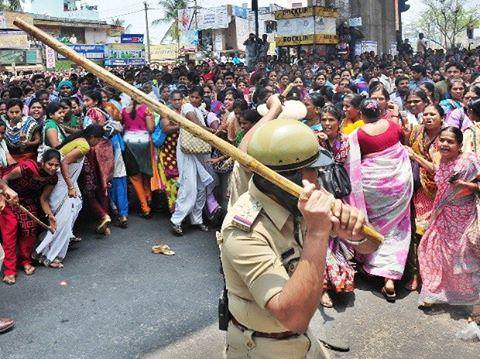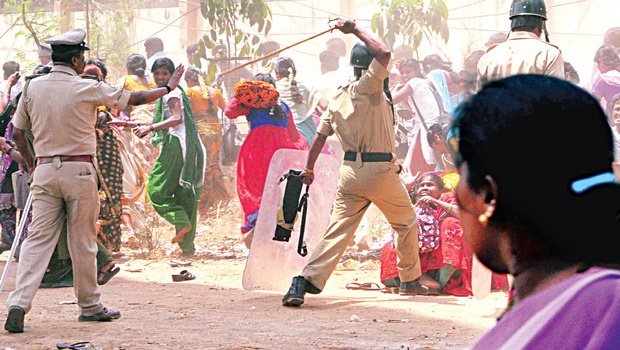It is said that “Privilege is when something is not a problem because it personally does not affect you.” These words though unsaid were certainly reflected by most people who failed to understand why hundreds of women workers protested and for what. Bengaluru, the entire city and its outskirts was alarmed on Tuesday (19th April 2016) as over 1.25 lakh enraged factory workers – mostly of whom were women – took to the streets in key parts of the city and rural areas, blocking traffic, pelting stones and burning vehicles. While to the 9-5 IT employees, it was the regular traffic jam plus a few more hours in their air conditioned cars, for the women out there protesting on roads, it was their means to get justice. What led them to do this is something we all must know.
It is almost always that we forget that Bengaluru is not just about IT industries, the city of gardens and a cosmopolitan network, but also the agglomeration of industries. It is an interesting fact that most of these factories employ more than 85% of women workers. While one might be surprised about this fact and also might take this up as an indication of ‘women empowerment’ but the real reason as to why these industries have a majority of women is this – women are assumed not to protest against the interests of their male supervisor. Hence, this was a tactful move by the factory owners in order to ensure cheap and effective labour.
Garment workers, who work more than 8 hours a day were denied their provident fund returns according to the old rule. According to sources, on completion of five years, the owner of the factory has to pay a gratuity, which is 15 days of wages per year. For an employee taking a salary of 5,000, on completion of five years, the management has to pay 2,500 for every year, which makes for an extra payment of 12,500. If the company has over 1,000 employees, it takes the gratuity burden to 1.25 crore. To save this, they never allow employees to complete five years. So they remove employees, make settlements, and in some cases, the PF is not paid at all. They would then reemploy such people afresh.
This ‘strategic’ move was undertaken with a complete crony capitalistic intention to earn more money at the cost of the lives of the workers. Women, being at the bottom of the socially disadvantaged people tend to suffer more because they cannot afford basic economic or social security. Funny part is that the PF provision affects all employees. Technically, everyone should have joined the protest. Why didn’t they? It is almost like we could see this city draw an imaginary line within itself, to segregate the have’s from the have not’s.
These women who work in factories not only face monetary injustice but also face harassment at work. Whether its commuting to work or working within the premises, their harassment stories are just mere whispers that pass on. While, anti-sexual harassment committees are set up in theory, its efficiency is never checked. For example, an RTI was filed by the Government Labour Union to the Karnataka Commission for Women to investigate the working of these committees, to which the response they received was that ‘they don’t have any information’ regarding the working of such committees.

Credit: Satyendra Satyarthi/ Facebook
The women face constant torture both mentally and physically. Which is why this was more than ‘just a protest’ for them. It was cry out loud for humane working and living conditions of workers. Snatching away savings is the worst nightmare they could ever face. Hence, all this should be considered before we come up with the conclusion that ‘they could have done something else’ and avoid the protest.
Meanwhile, the protest got violent. There was damage of public property, A few buses were burnt and around 100 people were injured. “We just want our PF Money back, we want justice,” they exclaimed while the police ruthlessly beat them up to make way for the traffic. The women sat for hours together with a determination to get their PF back. This monstrous provision was withdrawn later this week however it still poses these questions question – Do we care? Can we look at this issue beyond just looking at it as a traffic jam? Aren’t people who protest for basic human necessities wrongly termed – troublemakers and people who incite violence?
The next time we go to buy our new white shirt or a new leather jacket, lets once think about what people have to go through in order to satisfy our greed. The daily minimum wage of a worker in a factory is three times lesser than what we spend on a fancy lunch. These protests were a wake up call, to look at the world beyond our comfort bubble. Let’s rationalize before we judge.
About the author(s)
Works as a Policy Officer at the Centre for Internet and Society. Views are personal.




